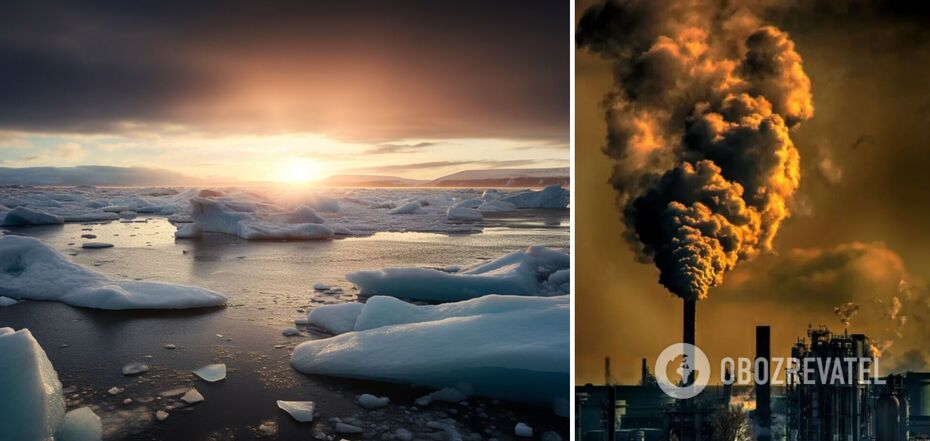Life
Scientists: Earth's karmic revenge on humanity is hidden in Antarctica
Every piece of Antarctic ice and snow contains the story of all humanity's man-made sins. When global warming causes this ice to melt, not only will the oceans rise, but something even worse will happen. The chemicals that humanity has been recklessly releasing into the atmosphere since the beginning of the Industrial Revolution will return to the air and water.
This is the opinion of Crispin Halsall, a chemist at Lancaster University in the UK. According to Wired, he believes that the Antarctic ice can tell the story of how people have treated the planet.
"These layers of snow are becoming an environmental record of pollution that goes back decades," Halsall says.
He explains that when icebergs and glaciers melt, the pollutants contained inside are released back into the seas, waterways and air. The released harmful molecules damage ecosystems, deplete the ozone layer and affect global weather.
Global warming is not making the situation any easier. Already, the melting of snow caps in the Alps and Himalayas is releasing old pollutants "locked in the ice for many decades".
Researchers have also recently learned that, despite popular belief, chemicals in the ice at the Earth's poles continue to "live". Therefore, what has been trapped for many years can be transformed.
Previously, scientists assumed that frozen pollutants remained inert, as freezing is known to slow down processes. But laboratory studies have shown that many pollutants, when illuminated with bright light that mimics the sun, decompose faster in ice than in liquid water.
The researchers attribute this chemical activity to a phenomenon known as the freezing concentration effect.
"Substances dissolved in water are displaced from the crystal structure of ice. With the naked eye, it looks like a frozen ice cube. But under a microscope, you can see small pockets of liquid where other chemicals are concentrated. When the reagents were placed in this tiny volume together, it made the chemical reaction faster," said Amanda Grannas, a chemist at Villanova University in the United States.
In nature, however, the chemical breakdown of concentrated pollutants is triggered by the ultraviolet light contained in sunlight. This accelerated rate of decay can be even more pronounced in ice at the poles, where "you can have 24 hours of sunlight at certain times of the year," Grannas explained.
"This stimulates a lot of chemical reactions," she said.
Scientists at the Central South University in China also found that microplastics, fragments of plastic less than 5 millimetres long, also break down faster in ice than in water. The chemists found that microplastic beads with a diameter of less than a thousandth of a millimetre broke down in ice in 48 days, the same way they did in the Yangtze River in 33 years.
Meanwhile, around 10 million tonnes of plastic ends up in the ocean every year, much of which breaks down into microplastics - so the ice at the poles can pass it through. On the one hand, this could be good news, as it could lead scientists to new methods to break down microplastics faster.
But microplastics broken into even smaller pieces in ice pose a threat not only to the environment but also to living organisms. It is known that the smaller the plastic fragments become, the deeper they penetrate into organisms. Earlier, scientists found microscopic plastic particles in the brains of fish. Of course, such an intervention did not go unnoticed and led to brain damage.
Halsall is also concerned about the so-called "everlasting chemicals" - perfluoroalkyl and polyfluoroalkyl substances, or PFAS, found in non-stick pans, motor oils and all kinds of consumer products.
In 2017, Halsall's team extracted a 10-metre-long cylinder of packed snow in the Antarctic that had been accumulating since 1958. There, they found that the decline in the content of everlasting chemicals has been noticeable since 2000, when chemical companies abandoned them en masse. But those PFAS that remain in older layers of snow not only decompose under UV light, but also turn into even more toxic ones.
For example, Grannas and her colleagues found that the chemical aldrin, which was previously used in pesticides, can easily turn into the even more toxic chemical dieldrin in ice.
Grannas says that studying how ice decomposes pollutants will help researchers evaluate new substances and understand what to expect in the future.
"We are introducing new chemicals into our agricultural systems, pharmaceuticals and everyday products such as laundry detergents, fragrances and personal care products. We want to understand in advance what will happen if we use them on a massive scale and release them into the environment," she said.
Earlier OBOZREVATEL told about the forecast of scientists, who declared about a new threat for mankind due to melting of glaciers.
Subscribe to OBOZREVATEL's Telegram and Viber channels to keep up with the latest news.



























